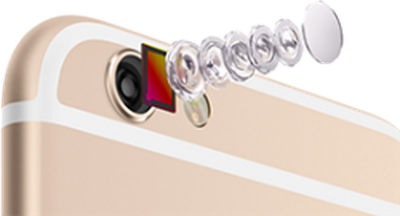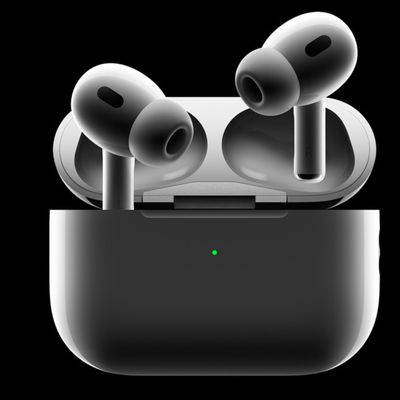iPhone 6s Rear Camera Rumored to Retain 8-Megapixel Sensor
 iPhone camera module supplier Largan Precision is expected to face limited earnings growth this year amid rumors that Apple's next-generation smartphone will retain an 8-megapixel rear-facing camera sensor, according to Taipei Times (via GforGames).
iPhone camera module supplier Largan Precision is expected to face limited earnings growth this year amid rumors that Apple's next-generation smartphone will retain an 8-megapixel rear-facing camera sensor, according to Taipei Times (via GforGames).
The report cites Taipei-based analyst Jeff Pu, who claims the iPhone 6s will have the same camera hardware specifications as previous models. Apple first introduced an 8-megapixel rear camera on the iPhone 4s in 2011 and used similar modules for the iPhone 5, iPhone 5c and iPhone 5s.
Pu said that the camera specifications of the next-generation iPhone, dubbed iPhone 6S, will stay the same as the current iPhone 6 at 8-megapixels, limiting potential catalysts to push Largan’s stock price higher in the second half of the year. [...] Pu said that although the migration to 8-megapixel and 13-megapixel lenses would remain strong among Chinese vendors of mid-tier and low-end phones, upgrades to 16-megapixel and 20-megapixel lenses for flagship phones would be slow given the limited supply of CMOS sensors — used to convert light into electrons.
While details surrounding the so-called "iPhone 6s" remain limited, this report is consistent with Largan Precision's stock price dipping early last year amid rumors the iPhone 6 camera would retain an 8-megapixel sensor. Meanwhile, it was reported in November that the iPhone 6s and iPhone 6s Plus could have the "biggest camera jump ever" with a dual-lens, DSLR-quality system.
Popular Stories
The long wait for an Apple Watch Ultra 3 appears to be nearly over, and it is rumored to feature both satellite connectivity and 5G support.
Apple Watch Ultra's existing Night Mode
In his latest Power On newsletter, Bloomberg's Mark Gurman said that the Apple Watch Ultra 3 is on track to launch this year with "significant" new features, including satellite connectivity, which would let you...
The iPhone 17 Pro Max will feature the biggest ever battery in an iPhone, according to the Weibo leaker known as "Instant Digital."
In a new post, the leaker listed the battery capacities of the iPhone 11 Pro Max through to the iPhone 16 Pro Max, and added that the iPhone 17 Pro Max will feature a battery capacity of 5,000mAh:
iPhone 11 Pro Max: 3,969mAh
iPhone 12 Pro Max: 3,687mAh...
Apple's next-generation iPhone 17 Pro and iPhone 17 Pro Max are just over two months away, and there are plenty of rumors about the devices.
Below, we recap key changes rumored for the iPhone 17 Pro models.
Latest Rumors
These rumors surfaced in June and July:Apple logo repositioned: Apple's logo may have a lower position on the back of the iPhone 17 Pro models, compared to previous...
The upcoming iPhone 17 Pro and iPhone 17 Pro Max are rumored to have a slightly different MagSafe magnet layout compared to existing iPhone models, and a leaked photo has offered a closer look at the supposed new design.
The leaker Majin Bu today shared a photo of alleged MagSafe magnet arrays for third-party iPhone 17 Pro cases. On existing iPhone models with MagSafe, the magnets form a...
Apple's position as the dominant force in the global true wireless stereo (TWS) earbud market is expected to continue through 2025, according to Counterpoint Research.
The forecast outlines a 3% year-over-year increase in global TWS unit shipments for 2025, signaling a transition from rapid growth to a more mature phase for the category. While Apple is set to remain the leading brand by...
iOS 26 and iPadOS 26 add a smaller yet useful Wi-Fi feature to iPhones and iPads.
As spotted by Creative Strategies analyst Max Weinbach, sign-in details for captive Wi-Fi networks are now synced across iPhones and iPads running iOS 26 and iPadOS 26. For example, while Weinbach was staying at a Hilton hotel, his iPhone prompted him to fill in Wi-Fi details from his iPad that was already...
Apple today seeded the second betas of upcoming iOS 18.6 and iPadOS 18.6 updates to public beta testers, with the betas coming just a day after Apple provided the betas to developers. Apple has also released a second beta of macOS Sequoia 15.6.
Testers who have signed up for beta updates through Apple's beta site can download iOS 18.6 and iPadOS 18.6 from the Settings app on a compatible...
 iPhone camera module supplier Largan Precision is expected to face limited earnings growth this year amid rumors that Apple's next-generation smartphone will retain an 8-megapixel rear-facing camera sensor, according to Taipei Times (via GforGames).
iPhone camera module supplier Largan Precision is expected to face limited earnings growth this year amid rumors that Apple's next-generation smartphone will retain an 8-megapixel rear-facing camera sensor, according to Taipei Times (via GforGames).


















